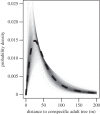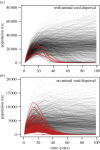Loss of animal seed dispersal increases extinction risk in a tropical tree species due to pervasive negative density dependence across life stages
- PMID: 25392471
- PMCID: PMC4262173
- DOI: 10.1098/rspb.2014.2095
Loss of animal seed dispersal increases extinction risk in a tropical tree species due to pervasive negative density dependence across life stages
Abstract
Overhunting in tropical forests reduces populations of vertebrate seed dispersers. If reduced seed dispersal has a negative impact on tree population viability, overhunting could lead to altered forest structure and dynamics, including decreased biodiversity. However, empirical data showing decreased animal-dispersed tree abundance in overhunted forests contradict demographic models which predict minimal sensitivity of tree population growth rate to early life stages. One resolution to this discrepancy is that seed dispersal determines spatial aggregation, which could have demographic consequences for all life stages. We tested the impact of dispersal loss on population viability of a tropical tree species, Miliusa horsfieldii, currently dispersed by an intact community of large mammals in a Thai forest. We evaluated the effect of spatial aggregation for all tree life stages, from seeds to adult trees, and constructed simulation models to compare population viability with and without animal-mediated seed dispersal. In simulated populations, disperser loss increased spatial aggregation by fourfold, leading to increased negative density dependence across the life cycle and a 10-fold increase in the probability of extinction. Given that the majority of tree species in tropical forests are animal-dispersed, overhunting will potentially result in forests that are fundamentally different from those existing now.
Keywords: extinction; overhunting; seed dispersal; spatial model; tree population; tropical forest dynamics.
© 2014 The Author(s) Published by the Royal Society. All rights reserved.
Figures






References
-
- Corlett RT. 2007. The impact of hunting on the mammalian fauna of tropical Asian forests. Biotropica 39, 292–303. (10.1111/j.1744-7429.2007.00271.x) - DOI
-
- Harrison RD. 2011. Emptying the forest: hunting and the extirpation of wildlife from tropical nature reserves. BioScience 61, 919–924. (10.1525/bio.2011.61.11.11) - DOI
-
- Terborgh J. 2013. Using Janzen–Connell to predict the consequences of defaunation and other disturbances of tropical forests. Biol. Conserv. 163, 7–12. (10.1016/j.biocon.2013.01.015) - DOI
-
- Peres CA, Palacios E. 2007. Basin-wide effects of game harvest on vertebrate population densities in Amazonian forests: implications for animal-mediated seed dispersal. Biotropica 39, 304–315. (10.1111/j.1744-7429.2007.00272.x) - DOI
Publication types
MeSH terms
Associated data
LinkOut - more resources
Full Text Sources
Other Literature Sources
Molecular Biology Databases

